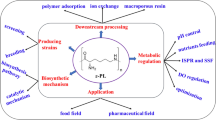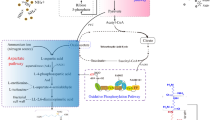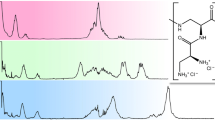Abstract
Poly(ε-l-lysine) (ε-PL) is a naturally-occurring l-lysine homopolymer having antimicrobial activity. A newly-isolated strain of Streptomyces aureofaciens produced a short chain length ε-PL consisting of 5–20 residues at the highest production level of 4.5 g l–1. This ε-PL had different spectra in terms of antimicrobial activity from the ε-PL that is now used as a food preservative. The high productivity was based on multiple metabolic pathways for l-lysine synthesis, and a great flux from l-lysine to ε-PL. The usefulness of this new ε-PL and its producing strain was discussed.




Similar content being viewed by others
References
Aranaz I, Mengíbar M, Harris R et al (2009) Functional characterization of chitin and chitosan. Curr Chem Biol 3:203–230
Hiraki J, Ichikawa T, Ninomiya S et al (2003) Use of ADME studies to confirm the safety of ε-polylysine as a preservative in food. Regul Toxicol Pharmacol 37:328–340
Hirohara H, Takehara M, Saimura M et al (2006) Biosynthesis of poly(ε-l-lysine)s in two newly isolated strains of Streptomyces sp. Appl Microbiol Biotechnol 73:321–331
Hirohara H, Saimura M, Takehara M et al (2007) Substantially monodispersed poly(ε-l-lysine)s frequently occurred in newly isolated strains of Streptomyces sp. Appl Microbiol Biotechnol 76:1009–1016
Kenawy E-R, Worley SD, Broughton R (2007) The chemistry and applications of antimicrobial polymers: a state-of-the-art review. Biomacromolecules 8:1359–1384
Obst M, Steinbüchel A (2004) Microbial degradation of poly(amino acid)s. Biomacromolecules 5:1166–1176
Oppermann-Sanio FB, Steinbüchel A (2002) Occurrence, functions and biosynthesis of polyamides in microorganisms and biotechnological production. Naturwissenschaften 89:11–22
Rogers KS, Boots MR, Boots SG (1972) Molecular interactions of six aromatic competitive inhibitors with bovine liver glutamate dehydrogenase. Biochim Biophys Acta 258:343–350
Saimura M, Takehara M, Mizukami S et al (2008) Biosynthesis of nearly monodispersed poly(ε-l-lysine) in Streptomyces species. Biotechnol Lett 30:377–385
Shima S, Sakai H (1977) Polylysine produced by Streptomyces. Agric Biol Chem 41:1807–1809
Shima S, Fukuhara Y, Sakai H (1982) Inactivation of bacteriophages by ε-poly-l-lysine produced by Streptomyces. Agric Biol Chem 46:1917–1919
Shima S, Matsuoka H, Iwamoto T et al (1984) Antimicrobial action of ε-poly-l-lysine. J Antibiot 37:1449–1455
Takehara M, Saimura M, Inaba H, Hirohara H (2008) poly(γ-l-diaminobutanoic acid), a novel poly(amino acid), coproduced with poly(ε-l-lysine) by two strains of Streptomyces celluloflavus. FEMS Microbiol Lett 286:110–117
Yamanaka K, Maruyama C, Takagi H, Hamano Y (2008) ε-Poly-l-lysine dispersity is controlled by a highly unusual nonribosomal peptide synthetase. Nat Chem Biol 4:766–772
Yoshida T, Nagasawa T (2003) ε-Poly-l-lysine: microbial production, biodegradation and application potential. Appl Microbiol Biotechnol 62:21–26
Acknowledgments
We thank Chisso (Tokyo) for providing the purified ε-PL samples.
Author information
Authors and Affiliations
Corresponding author
Rights and permissions
About this article
Cite this article
Takehara, M., Hibino, A., Saimura, M. et al. High-yield production of short chain length poly(ε-l-lysine) consisting of 5–20 residues by Streptomyces aureofaciens, and its antimicrobial activity. Biotechnol Lett 32, 1299–1303 (2010). https://doi.org/10.1007/s10529-010-0294-9
Received:
Accepted:
Published:
Issue Date:
DOI: https://doi.org/10.1007/s10529-010-0294-9




